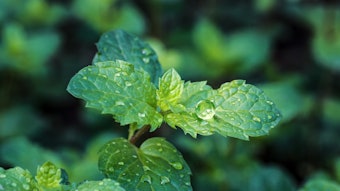The essential oil from peppermint, Mentha x piperita L., is one of the most widely used oils by the flavor industry for mint flavoring. However, abundant literature and experts’ observations report the varying composition and organoleptic profiles of peppermint oils according to the region of production, climatic variation and harvest date. Such variation is well illustrated and summarized by Brian Lawrence in his thorough reviews of peppermint oil. Methods to standardize peppermint oils by adding specific mint fractions or compounds isolated from other mint species, as well as other natural non-mint isolates were explored by Moyler and Moss.6 When fractions or isolates of oils from Mentha species other than piperita are used, as well as other natural flavors, the label of the blend must be identified as WONF (With Other Natural Flavors). In this paper we present the oil from our selected Mentha x aquatica L. (“Aquamint”) that can be blended to an M. x piperita oil to increase the menthofuran to match a standard “Yakima” oil.
The Plant: Benefits to the Grower Aquamint originated as a seedling from a poly-cross between the female (seed) parent M. aquatica L. and a pollinator from an unknown Mentha species. The parentage and chemotype of the selection strongly suggests that it is a hybrid plant from M. aquatica, and the DNA content as analyzed by flow cytometry is the same as that of M. aquatica. The seed parent is male sterile and rarely, though occasionally, outcrosses with other Mentha species. Seedlings that developed from the female parent were planted in observation plots; plant vigor and disease development were recorded. Selected seedlings were harvested and distilled for oil collection.
Aquamint, unlike its parent and many M. aquatica plants, has an upright and compact growth habit similar to M. x smithiana with lateral branches at each node of the main stem (Figure 1). The shape of the leaves of Aquamint confirms the variations of the species.7 Mature leaves at the bottom of the main stems are ovate lanceolate, while leaves on secondary branches and immature upper leaves are more lanceolate. The inflorescence of Aquamint varies somewhat in shape and color. Floral arrangements are whorls in leaf axils similar to M. arvensis, but with small bracts similar to M. aquatica. Figure 1 also illustrates the capacity of Aquamint to develop runners (stolon), which shows the potential of the plant for rapid spread and field establishment.










